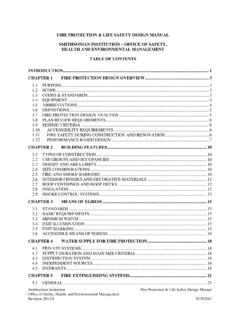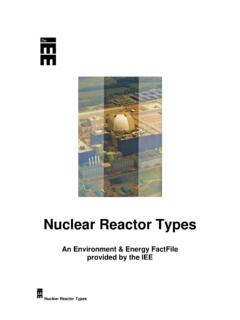Transcription of ELECTRICAL DISTRIBUTION POWER SYSTEMS OF …
1 - 201 - 2nd International Conference on Energy SYSTEMS and Technologies 18 21 Feb. 2013, Cairo, Egypt ELECTRICAL DISTRIBUTION POWER SYSTEMS OF MODERN CIVIL AIRCRAFTS Reyad Abdel-Fadil1, Ahmad Eid1, Mazen Abdel-Salam2 1 ELECTRICAL Engineering Dept., Aswan University, Aswan 81542, Egypt 2 ELECTRICAL Engineering Dept., Assiut University, Assiut 71518, Egypt As the aircraft industry is moving towards the all electric and More Electric Aircraft (MEA), there is increase demand for ELECTRICAL POWER in the aircraft. The trend in the aircraft industry is to replace hydraulic and pneumatic SYSTEMS with ELECTRICAL SYSTEMS achieving more comfort and monitoring features. Moreover, the structure of MEA DISTRIBUTION system improves aircraft maintainability, reliability, flight safety and efficiency.
2 Detailed descriptions of the modern MEA generation and DISTRIBUTION SYSTEMS as well as the POWER converters and load types are explained and outlined. MEA ELECTRICAL DISTRIBUTION SYSTEMS are mainly in the form of multi-converter POWER electronic system . Keywords: More electric aircraft, POWER converters, Electric actuations, Variable frequency, VSCF INTRODUCTION The conventional aircraft utilizes a combination of hydraulic, electric, pneumatic and mechanical POWER transfer SYSTEMS . Increasing use of electric POWER is seen as the direction of technological opportunity for advanced aircraft POWER SYSTEMS based on rapidly evolving technology advancements in POWER electronics, fault-tolerant ELECTRICAL POWER DISTRIBUTION SYSTEMS and electric driven primary flight control actuator SYSTEMS [1].
3 The concept of More Electric Aircraft (MEA) implies increasing use of ELECTRICAL POWER to drive aircraft subsystems that in the conventional aircraft, have been driven by a combination of mechanical, hydraulic and pneumatic SYSTEMS .The objective of the MEA is to completely replace the non- ELECTRICAL POWER in the aircraft with electricity. This idea was first applied to meet the military for less overall weight of the aircraft, lower maintenance costs, higher reliability and better performance. With increasing capacity and rating of the civil aircrafts, the idea of MEA is also applied. The MEA concept is seen as the direction of aircraft POWER system technology in the future.
4 The future aircraft POWER system will employ multi-voltage level hybrid DC and AC SYSTEMS . Thus, MEA ELECTRICAL DISTRIBUTION SYSTEMS are mainly in the form of multi-converter POWER SYSTEMS . The ELECTRICAL system of modern aircraft is a mixed voltages system which consists of the four types of voltage: 405 VAC (variable frequency), 200 VAC, 28 VDC and 270 VDC. - 202 - Aircraft ELECTRICAL POWER system often consists of two or more engine-driven-generators to supply the AC loads throughout the aircraft. All aircraft SYSTEMS needs AC and DC POWER altogether. The DC POWER comes from rectification of the AC POWER using transformer rectifier units (TRUs).
5 These units are normally 12-pulse configuration [2-3]. Due to cyclic operation of these units, they are considered as harmonic sources in the aircraft electric POWER system . These units can increase the voltage distortion and the harmonic contents into the AC side of the aircraft electric POWER system . The constant-speed drive (CSD) generating system found onboard many aircrafts is comprised of a three-stage regulated synchronous generator, the output frequency of which is maintained constant by means of a hydro-mechanical CSD connecting it to the engine via a gearbox. A reduction in the weight of the system is brought about by a combination of the drive and the generator integrated into a single unit, thereby providing the integrated drive generator (IDG) [4].
6 However, continuing developments in POWER electronics and microprocessor technology have led to the DC-link variable-speed constant-frequency (VSCF) generating system [5], becoming a viable alternative to the CSD and IDG SYSTEMS . The VSCF ELECTRICAL system is more flexible compared to the CSD/IDG SYSTEMS since its components can be distributed throughout the aircraft, in contrast to the CSD/IDG mechanical system in which they must inevitably be located close to the engine. POWER GENERATION SOURCES OF AIRCRAFTS The ELECTRICAL POWER SYSTEMS of aircrafts have made much progress in recent years because the aircrafts depend more and more on electricity as shown in Fig.
7 1. The voltage 28 VDC was the classical ELECTRICAL POWER system from 1940s to 1950s [6]. There were one or two DC batteries to support the essential loads during an emergency. The voltage 200 VAC supplies the AC load. The 200 VAC at 400Hz constant frequency (CF) aircraft system started on the 1960s. The variable-frequency (VF) generations appeared since 1990s and the load management SYSTEMS and backup generators. Variable-speed constant-frequency (VSCF) aircraft appeared on 2000 and continues to-date as shown in This VSCF aircrafts contains a constant DC bus of 270 VDC and for feeding AC loads; three-phase inverters are used. These new system of VSCF contains a lot of harmonics due to the existing of POWER converters.
8 To meet the standards of harmonic contents passive filters [1] and active POWER filters [2], [5] are used. The generation POWER rating of Boeing and Airbus increased over the years until it reaches 800kVA for Airbus A380 while it reaches 1400kVA for Boeing B787 as shown in Fig. 1-b. Different aircraft POWER ratings with their used technologies [7] are listed in Table 1. These aircraft SYSTEMS are highlighted as follows. 1- CSD/IDG Generating system This type of engine drive, as used in conventional aircraft, has constant speed drive (CSD) by hydro-mechanical conversion at the Source as shown in Fig. 2-a. As the engine speed from is constant, the generator frequency is constant at 400Hz with a phase voltage of 115 VAC.
9 The system is expensive to purchase and maintain due the complexity of the hydro-mechanical drive system . - 203 - Figure 1. Development of aircraft POWER system and POWER rating of famous civil aircrafts Table 1. Generation, POWER Rating and Applications of Different Aircrafts Generation type Civil applications Military applications B777 2x120kVA A340 4x90kVA B737NG 2x90kVA MD-12 4X120kVA B747 4X120kVA B717 2X40kVA IDG/CF [115 VAC/400Hz] B767-400 2X120kVA Eurofighter Typhoon F18C/D 2X40/45kVA VSCF (Cycloconverter) [115 VAC/400Hz] F18E/F 2X60/65kVA B777(Backup) 2X20kVA VSCF(DC-Link) [115 VAC/400Hz] MD- 90 2X75kVA Cobal Ex 4X40kVA Horizon 4X25kVA VF [115 VAC/380-760Hz] A380 4X150kVA Boeing Jsf 2X50kVA VF [230 VAC] B787 4X250kVA 2- VSCF Generating system In this drive, the output speed is variable and consequently the output generator frequency is variable.
10 To provide an AC voltage with a constant frequency of 400Hz, a DC-link is formed between the generator side and the AC loads, as shown in Fig. 2-b using AC/DC and DC/AC POWER converters, or by using a cycloconverter (AC/AC converter) as shown in Fig. 2-c. The DC-link provides additional benefit for feeding high voltage loads and charging batteries [5]. - 204 - 3- VF Generating system In this technique, the speed of the engine is variable and hence, the generator frequency is varied from 360-800Hz with an output voltage of 200V. The VF drive system is the simplest form of generating POWER , cheapest and the most reliable. Variable frequency voltages have impact upon other aircraft subsystems like motors and controllers existed onboard.



